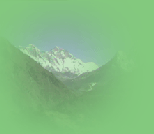|
MUSIC II
|
VISIT
|
PICTURES
|
INFO
|
KATHMANDU
|
|
PICTURES Pashupati Nath Temple
Everest
Carpet Weaving
|
GEOGRAPHY Elongated along the Himalayas, Nepal is a landlocked country with a total land area of 147,181 sq.km.. (56,136 sq.mi.). The country is bordered by the People's Republic of China to the North and the Republic of India to the South, East and West. Its topography varies from the high snow-clad peaks and the mid mountain region with fertile valleys to the southern plains known as Tare. So is the climate ranging from the alpine in the north to hot and humid in the southern plains. World's highest peak Mt. Sagarmatha (Everest), 8,848 meters (29028 ft.) lies in Nepal. Its capital, Kathmandu, is a valley with pleasant climate. The main rainy season is during the monsoon period (June to September) with rainfall of over 56 inches a year. The geography of Nepal is blessed with a number of small and large rivers. Three main river systems - Kosi, Gandaki and Karnali originate in the Himalayas, flow southward and empty into the Ganges. Nepal has been a habitat of different rare species of flora and fauna. In order to protect the fragile eco-system, Nepal has set up thirteen national parks and wildlife reserves in different parts of the country. FLAG The national flag of Nepal consists of two triangular figures with crimson coloured base and deep blue borders, there being a white emblem of crescent moon and a white emblem of sun in the lower part. NATIONAL Rhododendron Arboream is the national flower, Crimson is the national colour, Cow is the national animal and the Danphe (Lophophorus) is the national bird. HISTORY Throughout ages, Nepal has preserved its national identity and independence. It has never been under any foreign rule. Ancient Nepal was composed of many small autonomous principalities. Prithvi Narayan Shah unified Nepal in the present form in 1768. Kathmandu has been made the capital since then. After the 1814-1816 Anglo-Nepali war, the Mechi and Mahakali rivers became the eastern and western borders of the country. In 1846, Jung Bahadur Rana consolidated his powers as a Prime Minister. His family became hereditary prime ministers and ruled the country till 1950. Organized resistance against the Ranarchy began after the end of World War I. In 1940, four Nepalese youths were hanged to death for anti-Rana activities. This gained momentum after World War II. A popular revolution engineered by Shri B.P. Koirala overthrew the Rana Oligarchy in February 1951 culminating in a first experiment in democracy. King Tribhuvan promised Constituent Assembly Elections but could fulfill. After an arduous struggle by the people, first General Elections were held under multi-party system in February 1959. The Nepali Congress party won two thirds majority in the Lower House of the Parliament, making B.P. Koirala the first ever elected Prime Minister of Nepal. King Mahendra could not tolerate the democratic system of governance of the popularly elected government. Ultimately, the King staged a coup in December 1960, banned all political activities and imprisoned the Prime Minister and his comrades without trial till 1968. In January 1972, King Birendra ascended the throne and continued to remain the sole source of authority and exercised the broad powers over ;he country. The Palace preferred direct rule with iron hand but the people waged a relentless struggle even taking to arms sometimes. During 29-year long continuous struggle, thousands of multi-party enthusiasts suffered unspeakable pains. Hundreds were maimed, mutilated and martyred. B.P. Koirala passed away in 1982. Other weather-beaten leaders like Ganesh Man Singh, K.P. Bhattarai, Girija Prasad Koirala carried on the struggle as shown by the late Koirala. In the beginning of 1990 the Nepalese communists led by Man Mohan Adhikary collaborated with the Nepali Congress led peaceful movement for the restoration of multi-party democracy launched on the historic democracy day of Falgun 7 (February 18). People came on to the streets braving batons and bullets. With the loss of a great many precious lives, they won the political freedom, which is very dear to their heart. Capital punishment is now abolished. |
|





